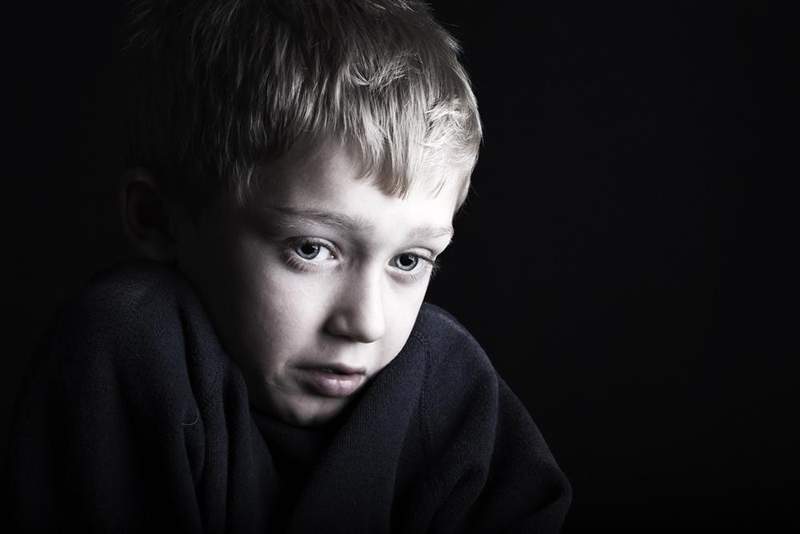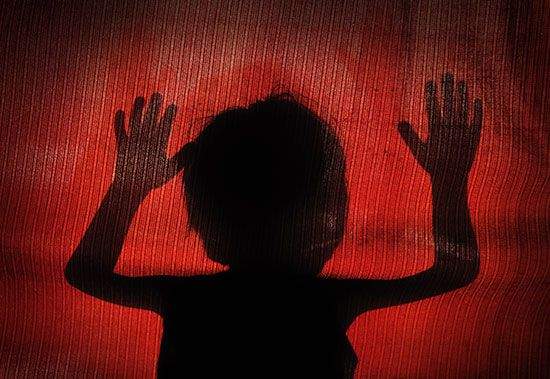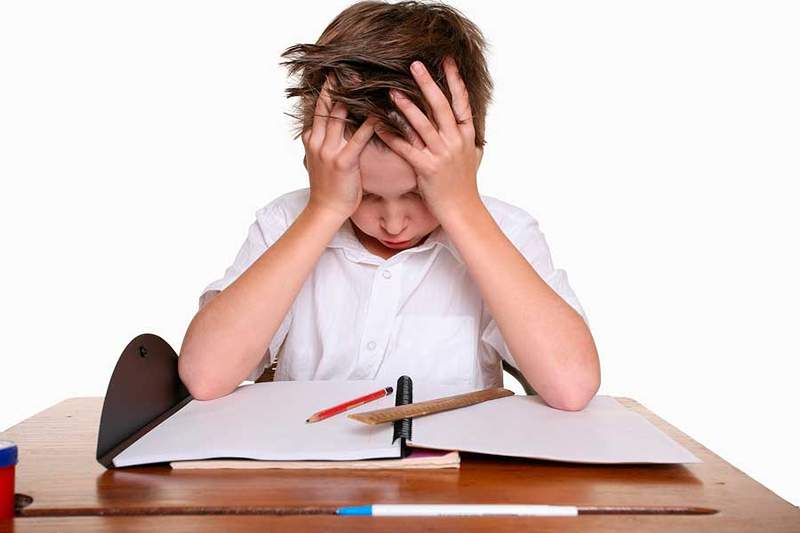Children's fears and phobias

- 1531
- 182
- Hugh Greenholt
Fears and phobias are common in childhood and can vary from normal and temporal fears to serious anxiety problems. It is important to understand that fears in childhood are a normal part of development and can arise as children explore the world and discover new challenges. However, when fears become excessive or interfere with the child's daily life, they can be considered phobias.
Some common fears in childhood include Fear of darkness, animals, monsters, storms and to be alone. These fears are usually temporary and decrease as children grow and develop coping skills.
Fears related to physical damage and dangers (not being able to breathe, burn, a car accident, a war ...) usually occur in both children and adolescents. The phobias to the animals that we find in adults are generated almost entirely in childhood, usually before 5 or 6 years. The fears/phobias of the blood-injection-injury type usually appear before the age of 7 and stay over the years.
Phobias, on the other hand, are irrational and excessive fears of specific objects, situations or animals. Phobias can significantly interfere with the child's daily life and can cause intense anxiety and emotional anguish. Some common phobias in childhood include the phobia of dogs, spiders, needles, closed places, among others.
Content
Toggle- Evaluation of children's fears
- General Inventories of Fears
- Social phobia, diagnostic criteria
- Treatment of phobias in childhood
- Social phobia
- Separation anxiety disorder
- Specific phobias
- Bibliographic references
Evaluation of children's fears
General Inventories of Fears
General inventories of fears are usually composed of two elements:
- A Extensive phobic stimulus list, approximately 50 and 100 items.
- A Fobia's intensity estimation scale, of three or five points, where the lower end equals "nothing of fear '" and the superior to "a lot or very fear"
In Spanish we have the Fears inventory, of which there is a version of 103 items (Pelechano, 1981) and a very similar one of 100 items (Pelechano 1984), both with a three -point scale for parents to evaluate their children's fears. We also have the Sosa fears inventory, Capafons, Conesa-Peraíeja, Martorell, Silva and Navarro (1993); This7 when the previous one is answered by the children, uses a three -point scale and includes 74 items plus an open final question: Is there anything more than scary?. We also found in Spanish the FSSC-R Children's Questionnaire (Fear Survey Shedule for Children-Review) by Olleridck, adapted by Chorot and Sandín.
Specific fears of fears They have the same format as general inventories, but focus on stimuli related to a specific topic such as school or hospital, so they are shorter. Inventory of School Fears (IME) of Méndez (1988). In Spanish, it contains 49 items and an open final: "Other fears related to the school" are designed to answer the school, but they can also fill out teachers and parents. Baccalaureate is applied from preschool (three to twenty years old).
During childhood and adolescence there is greater vulnerability to fear and consequently the development of phobias.
Fear estimation scales ("High ones") They consist of graduated scales, for example from zero (no fear) to ten (maximum fear), so that the duly trained child evaluates their level of anxiety- they are used when the child is in the dreaded situation, for example to evaluate the Anxiety produced by surgery is asked the child how much fear he feels at various times: on the eve of the operation, when going down to the operating room, before anesthesia, etc. They are also used during the application of other evaluation techniques. As in separation anxiety, etc. Like children, especially the little ones, they usually have difficulty granting numerical value at their level of anxiety, we usually use gestures or drawings (such as traffic lights, bar diagrams), an effective method when children cannot express their levels in values of fear is to paint faces in a cardboard with gestures of pleasure to dislike and behind it we give it a numerical value, by means of a piece that moves horizontally the child indicates the face that corresponds to what we ask him and we can see behind the corresponding and at the same time write it down.
Observation in natural environment It is difficult that these situations can observe them since the child tends to avoid phobic stimuli. Méndez and Maciá developed a class assistance record. Ortigosa and Méndez made another for responses in hospitalization situations.
Behavioral approach tests The child is asked to gradually approach the phobic stimulus to observe their anxiety responses. There are two ways:
- Active approach: The child becomes more and more approaches to the phobic stimulus.
- Passive exposure: The child remains in the same place while the phobic stimulus is approaching, or intensifying.
We have two types of measures:
- Measures of physical variables: Distance that separates the child from the phobic stimulus and what is approaching (centimeters or meters), time in seconds or minutes, light intensity, etc.
- Measures of psychological variables: The intensity of the phobic response is evaluated by means of a scale, which can be:
- Zero points: Null execution
- A point: Partial and/or fearful execution (start one of the approaches but interrupts it, it is delayed at the beginning, it ends it showing fear)
- Two points: total and safe execution; and! child completes one of the approaches without signals of anxiety.

Social phobia, diagnostic criteria
Social phobia, also known as social anxiety disorder, is a disorder in which the person experiences Intense and persistent fear in social or performance situations, fearing to be judged or negatively evaluated by others. For the diagnosis of social phobia, a complete clinical evaluation is required by a mental health professional, which includes the identification of the following signs and symptoms:
- Scary marked and persistent to one or more social or action situations in which the person is exposed to strangers or the possible evaluation of others. The individual fears acting (or showing symptoms of anxiety) that would be humiliating or embarrassing. In children there must be capacity for social relationships with appropriate family relationships, and anxiety must occur in relationships with other children, not only in interactions with adults.
- Exposure to the feared social situation almost invariably anxiety. which may consist of a situational or situationally predisposed panic attack. In children anxiety can manifest through tears, tantrums, immobilization or cowing with social situations with unknown people.
- The person recognizes that the fear is excessive or irrational (this characteristic is not necessary for children).
- Feared situations (social or action situations) are avoided, or they are supported with intense anxiety or discomfort.
- The avoidance, anxious, or right-hand (discomfort) associated with situations significantly interfere with the normal activity of the person, with their work or academic tasks, or with their social activities or relations, or-there is an intense right-hand to have the phobia.
- For people under 18, the duration of the symptoms must be at least six months.
What is social phobia?
Situations or activities that are usually avoided by adolescents with social phobia.
- Eating in public, especially in the school cafeteria
- Give an oral lesson
- Present to exams or contests
- Call a classmate for schools
- Ask the teacher for help or some clarification at school
- Lodge
- Work on a group project
- Gymnastics classes, music lessons and other activities based on performance
- Talk to people of authority, including the dependents of the stores or adult friends of the parents
- Call or invite a friend to do something
- Answer the phone or doorbell
- Attend activities after school, club meetings, dances, sporting events
- Start or join conversations with equals
- Situations that require assertiveness, such as telling someone to stop spending jokes or preventing them from copying their homework
- The appointments (stay with someone)
- Have to take a picture, especially for the school album
- Ask for food in a restaurant
 Children with slow learning
Children with slow learning Treatment of phobias in childhood
Social phobia
For the treatment of this disorder we will use exhibitions, contingency management, modeling and cognitive strategies.
Modeling will allow us to design therapeutic programs that improve possible deficit in social skills that usually come together to social phobia; It also brings us corrective information on the wrong expectations and beliefs related to social interaction. Thanks to modeling we will improve social skills, we will reduce the symptoms of anxiety or social withdrawal and enhance social contact behaviors In children (verbal contact with other children, frequency of social interaction, physical proximity- ...)
Both in social phobia and in other social anxiety problems (evaluation or test anxiety) are the self -affirmations of the type of type "commonEveryone is looking at me","I am stupid"And maladaptive negative expectations such as"I'm going to make a fool of". For all this we will use cognitive restructuring aimed at Modify maladaptive thoughts that can interfere with task -oriented problem solving behaviors.
Given the importance that social skills use in social phobia, and since many children have difficulties in this aspect we usually use the Training programs in social skills that normally imply the education phase to teach appropriate communication behaviors, such as smiling, they talk to look; a modeling phase and an operational phase (giving corrective feedback and reinforcement).
Separation anxiety disorder
We usually find this disorder associated with school phobia. Modeling use is quite successful, contingency management, exposure and cognitive strategies. After the evaluation we go on to create an intervention program that we mainly have to base it on promoting the activities that involve separation of parents and home. Usual these activities are going to school, going to friends house, going to play with other children, etc.
We begin by applying contingency management, for this, in the evaluation we will have obtained the background and consistent to the occurrence of separation anxiety, mainly with a record by the parents of one or two weeks. It is important that with these records we can identify what this behavior can be maintaining in the child.
What really interests us is what consequences the child gets after issuing behaviors. Once these are identified, we will apply parents extinction to the consequences that reinforce negatively, such as avoiding going to school, or positively, how to pay attention. That is, parents are usually negatively reinforcing the child by let.
They also usually pay close attention if it has not gone to school or even in the moments immediately after the issuance of behavior. This we always have to combine with differential reinforcement of incompatible behaviors as reinforcement when separating from parents, when attending school, etc. We also have to elaborate a hierarchy with the child from the generating situations of separation anxiety. Then we will go to the graduate exhibition, which is done in the same way as all the exhibitions.
Axiety for separation and school phobia: Useful tips
Specific phobias
We have four types of specific phobias:
- Animal type
- Environmental type
- Blood-Injection type
- Situational type
Before deciding some type of intervention on specific phobias we have to make sure that these are inappropriate fears for age, as long as they are not causing an important family disturbance. Many times it is not necessary to intervene and only to explain to parents that consists of a normal evolutionary phenomenon and usually tend to disappear with age, it is usually sufficient.
We will use the graduated exposure through a hierarchy of the phobic stimulus, In this way we get the child to gain confidence and reduce fear progressively as the hierarchy is completing. In the phobia to darkness, for example, we will graduate the exposure time, the place and the security signs (such as being accompanied by different people). For all specific phobias we will use the same, graduated exposure combined with auto instructions, incompatible responses such as imagining what a feat is doing and modeling.
Children with social anxiety are usually retracted, they are not "problematic", their phobia usually goes unnoticed by their parents and teachers. There is usually a tendency to think of shyness and social anxiety are normal phenomena during childhood and adolescence and that they overcome or disappear spontaneously with age, when the reality is that social phobia is possibly the anxiety disorder that refers more difficulty.
Bibliographic references
- Hernández, p., & Nieto, M. (2012). Children's fears: epidemiology, clinical characteristics and risk factors. Annals of Pediatrics, 76 (4), 217-223.
- Ruiz-Hernández, J. TO., & Rodríguez-Jiménez, T. (2010). Children's fears: how to understand and how to treat them. Journal of Psychopathology and Clinical Psychology, 15 (2), 101-111.
- Martínez-González, r. TO. (2012). Children's fears. Journal of Education Psychology, 7 (2), 63-77.
- Martínez-González, r. TO. (2014). Children's fears in school context: evaluation and treatment. Education XX1, 17 (1), 63-84.
- Téllez-Sánchez, J. L. (2011). Children's fears: what are they, what are they and how to treat them. Clinical Psychology Magazine with Children and Adolescents, 1 (2), 55-66.

